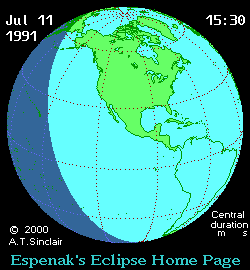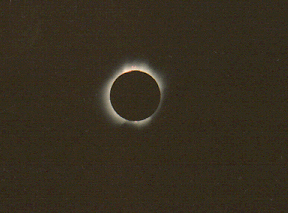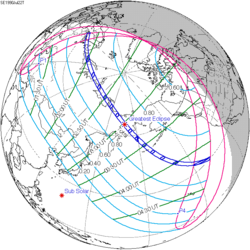Top Qs
Timeline
Chat
Perspective
Solar eclipse of July 11, 1991
Total eclipse From Wikipedia, the free encyclopedia
Remove ads
A total solar eclipse occurred at the Moon's descending node of orbit on Thursday, July 11, 1991,[1] with a magnitude of 1.08. A solar eclipse occurs when the Moon passes between Earth and the Sun, thereby totally or partly obscuring the image of the Sun for a viewer on Earth. A total solar eclipse occurs when the Moon's apparent diameter is larger than the Sun's, blocking all direct sunlight, turning day into darkness. Totality occurs in a narrow path across Earth's surface, with the partial solar eclipse visible over a surrounding region thousands of kilometres wide. Occurring about 8 hours after perigee (on July 11, 1991, at 11:00 UTC), the Moon's apparent diameter was larger.[2]
The eclipse lasted for 6 minutes and 53.08 seconds at the point of maximum eclipse. There will not be a longer total eclipse until June 13, 2132. This was the largest total solar eclipse of Solar Saros series 136. This eclipse was the most central total eclipse in 800 years, with a gamma of −0.00412. There will not be a more central eclipse for another 800 years. Its magnitude was also greater than any eclipse since the 6th century.
Totality began over the Pacific Ocean and Hawaii, moving across Mexico, down through the Central American countries of Guatemala, El Salvador, Honduras, Nicaragua, Costa Rica and Panama, across Colombia and ending over Brazil. A partial eclipse was visible for parts of southern Canada, the United States, Mexico, Central America, the Caribbean, and South America.
Remove ads
Observations
Summarize
Perspective

An observation team funded by the National Natural Science Foundation of China made near-infrared spectroscopic observations in the southern suburbs of La Paz, Baja California Sur, Mexico. Weather was clear on the eclipse day in La Paz. The team captured dozens of frames of the slitless spectrum of the upper layer of photosphere and chromosphere, and the slit spectrum outside the solar surface. They also captured images of the chromosphere and solar prominences. Among the professional observation teams from various countries to La Paz, six used the new CCD sensors for the first time in solar eclipse observation. Among them, the Chinese and Japanese team used it to observe long-wavelength spectra.[3] A team of 320 people from NASA's Johnson Space Center made observation in Mazatlán, Mexico. The local weather was not ideal in the days before the eclipse, but got slightly better as the eclipse day approached. Some people went to San Blas, Nayarit for better weather conditions. In the end, a hole in the clouds appeared in El Cid in western Mazatlan, through which the corona and prominences was visible. Other observers 1 to 5 miles away were clouded out. In San Blas, the corona and prominences were still visible, even though the clouds became thicker during totality.[4] Scientists from the Royal Observatory of Belgium, the Institute of Geodesy and Geophysics of the Chinese Academy of Sciences, and the Institute of Geophysics of the National Autonomous University of Mexico made observations in Mexico City to study the change in gravity during a total solar eclipse.[5]
Remove ads
Alleged ancient Maya prediction
The American ethnographer and anthropologist Victoria Bricker and her late husband and colleague Harvey Bricker, claim in their book "Astronomy in the Maya Codices" that by decoding pre-Columbian glyphs from the four Maya codices they discovered that pre-16th century Maya astronomers predicted the solar eclipse of July 11, 1991.[6] In their 2011 volume, the husband-wife Brickers team explain how they translated the dates from the Maya calendar, then used modern scientific knowledge of planetary orbits to line up the data from the Maya prediction with the Gregorian calendar.[7] Reviewers disputed the claim in 2014, concluding that, "loose hieroglyphic readings and accommodating pattern matching occurs throughout the book."[8]
Remove ads
Eclipse timing
Places experiencing total eclipse
Places experiencing partial eclipse
Remove ads
Gallery
- Partial phase before totality as seen through the cloud cover, Playas del Coco, Guanacaste, Costa Rica
- Totality as seen on the Mexican coast south of Mazatlan
In popular culture
The 1991 eclipse appears in the music video for Cosas del Amor, a duet by Vikki Carr and Ana Gabriel.[9]
Eclipse details
Summarize
Perspective
Shown below are two tables displaying details about this particular solar eclipse. The first table outlines times at which the Moon's penumbra or umbra attains the specific parameter, and the second table describes various other parameters pertaining to this eclipse.[10]
Remove ads
Eclipse season
This eclipse is part of an eclipse season, a period, roughly every six months, when eclipses occur. Only two (or occasionally three) eclipse seasons occur each year, and each season lasts about 35 days and repeats just short of six months (173 days) later; thus two full eclipse seasons always occur each year. Either two or three eclipses happen each eclipse season. In the sequence below, each eclipse is separated by a fortnight. The first and last eclipse in this sequence is separated by one synodic month.
Remove ads
Related eclipses
Eclipses in 1991
Metonic
- Preceded by: Solar eclipse of September 23, 1987
- Followed by: Solar eclipse of April 29, 1995
Tzolkinex
- Preceded by: Solar eclipse of May 30, 1984
- Followed by: Solar eclipse of August 22, 1998
Half-Saros
- Preceded by: Lunar eclipse of July 6, 1982
- Followed by: Lunar eclipse of July 16, 2000
Tritos
- Preceded by: Solar eclipse of August 10, 1980
- Followed by: Solar eclipse of June 10, 2002
Solar Saros 136
- Preceded by: Solar eclipse of June 30, 1973
- Followed by: Solar eclipse of July 22, 2009
Inex
- Preceded by: Solar eclipse of July 31, 1962
- Followed by: Solar eclipse of June 21, 2020
Triad
- Preceded by: Solar eclipse of September 9, 1904
- Followed by: Solar eclipse of May 11, 2078
Solar eclipses of 1990–1992
This eclipse is a member of a semester series. An eclipse in a semester series of solar eclipses repeats approximately every 177 days and 4 hours (a semester) at alternating nodes of the Moon's orbit.[11]
Saros 136
This eclipse is a part of Saros series 136, repeating every 18 years, 11 days, and containing 71 events. The series started with a partial solar eclipse on June 14, 1360. It contains annular eclipses from September 8, 1504 through November 12, 1594; hybrid eclipses from November 22, 1612 through January 17, 1703; and total eclipses from January 27, 1721 through May 13, 2496. The series ends at member 71 as a partial eclipse on July 30, 2622. Its eclipses are tabulated in three columns; every third eclipse in the same column is one exeligmos apart, so they all cast shadows over approximately the same parts of the Earth.
The longest duration of annularity was produced by member 9 at 32 seconds on September 8, 1504, and the longest duration of totality was produced by member 34 at 7 minutes, 7.74 seconds on June 20, 1955. All eclipses in this series occur at the Moon’s descending node of orbit.[12]
Metonic series
The metonic series repeats eclipses every 19 years (6939.69 days), lasting about 5 cycles. Eclipses occur in nearly the same calendar date. In addition, the octon subseries repeats 1/5 of that or every 3.8 years (1387.94 days). All eclipses in this table occur at the Moon's descending node.
Tritos series
This eclipse is a part of a tritos cycle, repeating at alternating nodes every 135 synodic months (≈ 3986.63 days, or 11 years minus 1 month). Their appearance and longitude are irregular due to a lack of synchronization with the anomalistic month (period of perigee), but groupings of 3 tritos cycles (≈ 33 years minus 3 months) come close (≈ 434.044 anomalistic months), so eclipses are similar in these groupings.
Inex series
This eclipse is a part of the long period inex cycle, repeating at alternating nodes, every 358 synodic months (≈ 10,571.95 days, or 29 years minus 20 days). Their appearance and longitude are irregular due to a lack of synchronization with the anomalistic month (period of perigee). However, groupings of 3 inex cycles (≈ 87 years minus 2 months) comes close (≈ 1,151.02 anomalistic months), so eclipses are similar in these groupings.
Remove ads
Notes
References
Wikiwand - on
Seamless Wikipedia browsing. On steroids.
Remove ads










































































































